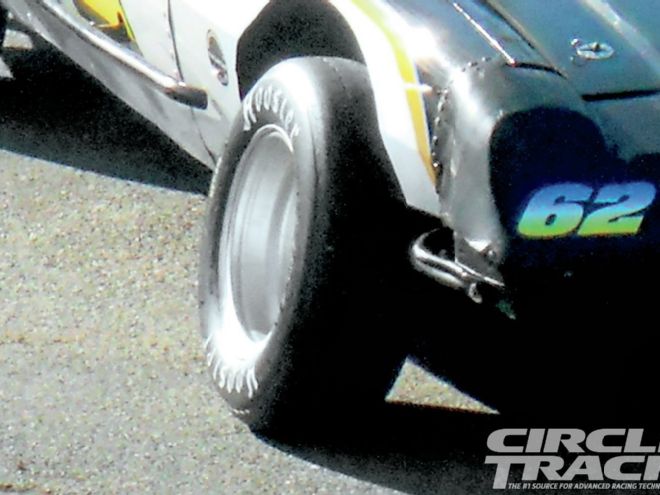
Tire camber is when a wheel is tilted so that the top of the tire is either closer to the centerline of the car or further from it. Negative camber is when the top of the tire is closer to the center of the car than the bottom of the tire. Positive camber is when the opposite is true, the top of the tire is further away from the center of the car than the bottom of the tire.
Circle Track Camber
In circle track racing turning left, we use positive camber on the left front wheel of the car and negative camber on the RF wheel. We can easily check the amount of camber by using a camber gauge and reading the amount directly on the camber bubble vial or digital gauge.
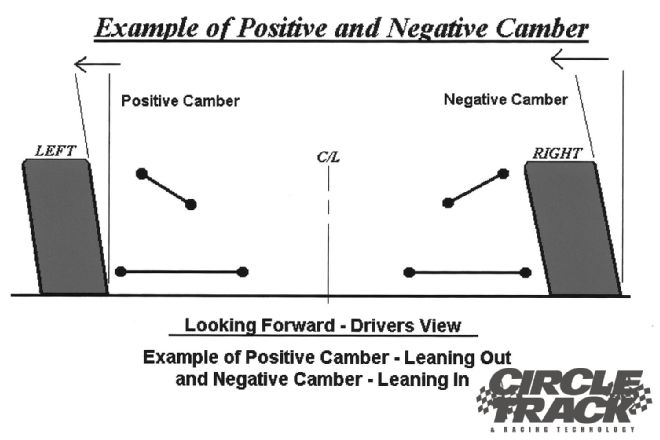 <strong>1</strong>. From a driver’s view, the positive left front camber causes the top of that tire to lean out away from the centerline of the car. The opposite is true of the RF tire which has negative camber. On that wheel, the top of the tire leans in toward the centerline.
<strong>1</strong>. From a driver’s view, the positive left front camber causes the top of that tire to lean out away from the centerline of the car. The opposite is true of the RF tire which has negative camber. On that wheel, the top of the tire leans in toward the centerline.
In our test of the two types of camber gauges, the camber readings came out the same for both gauges. Make sure the car is at ride height with all of the weight in the car including the driver. Air the tires up to operating pressures. These settings may change once the car is raced and the tire temperatures have been evaluated.
We have learned some interesting and important aspects of tire camber for short track racing. We have always known that a racing tire will flex under the stress of cornering and the tread will move and roll under the wheel when the extreme forces associated with cornering are present. Different brands of tires have different stiffness of sidewall construction and therefore roll over more or less.
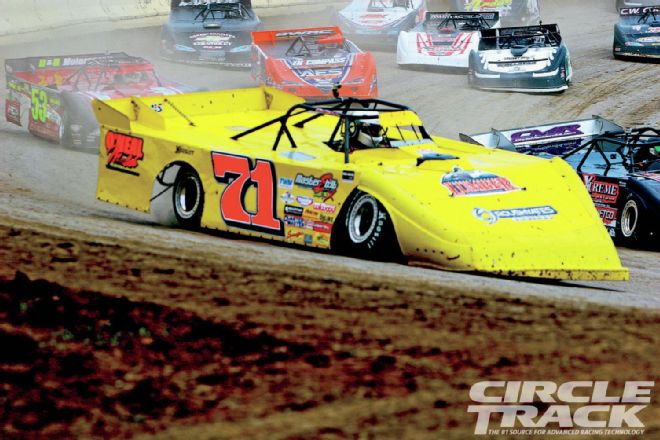 With more extreme travel seen on both dirt and asphalt cars when using softer spring setups, we see more camber change. With the bump devices, the cambers do not change once the front end is down on the bumps because the chassis has very little vertical movement with those setups.
With more extreme travel seen on both dirt and asphalt cars when using softer spring setups, we see more camber change. With the bump devices, the cambers do not change once the front end is down on the bumps because the chassis has very little vertical movement with those setups.
Tire temperatures tell us more about how much static camber we need than anything else. The overall goal is that we need the tire contact patch to have the greatest area or footprint on the racing surface at mid-turn in order for the tire to be able to provide the maximum amount of traction it is capable of giving.
Tire temperatures can alert us to improperly set static cambers. A front tire that is much hotter on the inside edge (side toward the inside of the racetrack) usually has too much positive camber in the case of a LF wheel, or too much negative camber if it is the RF wheel.
Important Note: We are learning more about proper camber settings for the front tires and the key to setting initial cambers for your car is to know the change in attitude of the front of the car from static ride height to dynamic ride height.
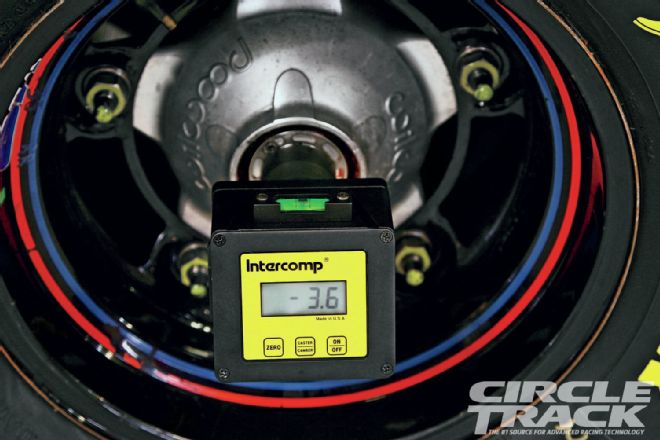 <strong>2</strong>. For measuring camber, just read the amount on the vial for a manual gauge or the display on a digital gauge with the wheel pointed straight ahead.
<strong>2</strong>. For measuring camber, just read the amount on the vial for a manual gauge or the display on a digital gauge with the wheel pointed straight ahead.
With the new setups running softer ride springs, riding on bumps with the resulting low attitudes and small roll angles, the cambers must be set to be correct at that position. It is relatively unimportant what the cambers are at ride height because the car will not operate in that position when you are racing.
Camber Change
The cambers will change as the car dives and rolls as it enters and negotiates a turn. True camber change is a product of both chassis dive and chassis roll. Gone are the days when we would jack up the wheel and measure how many degrees the camber changed in each inch of bump. Those numbers really don't tell us anything. That is only part of the answer. Chassis roll has an effect that adds or subtracts from what dive does. So, what we really need to know is what the dynamic camber ends up at after the car dives and rolls, just like it does in the turns.
The left front always loses a lot of camber, so we need to allow for that in setting the amount of static camber. Generally, if we end up with between 1/2 to 11/2 degrees of positive camber at the LF wheel after the car dives and rolls, then that tire will have the dynamic camber that it needs.
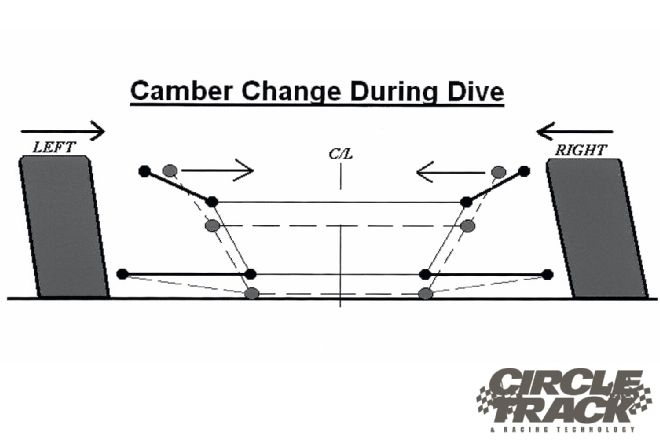 <strong>3</strong>. As the chassis dives, the upper ball joints are pulled in toward the centerline of the car. This causes a movement toward negative camber in both front wheels. The greater the angle of the upper control arms, the more change in camber from chassis dive. But this is not all that is happening.
<strong>3</strong>. As the chassis dives, the upper ball joints are pulled in toward the centerline of the car. This causes a movement toward negative camber in both front wheels. The greater the angle of the upper control arms, the more change in camber from chassis dive. But this is not all that is happening.
If we combine the effects of dive and roll, we see where the LF wheel will lose in both dive and roll where the RF dynamic camber will be a product of combining two movements that are in opposite directions. That is why we can achieve a net zero change in camber at the RF wheel with the more conventional setups. Modern Late Model soft spring setups develop high amounts of dive and very little roll.
The RF camber change is a little different. We can design our car so that the RF camber does not change after dive and roll or have both front wheels not change camber when running on bumps. Near zero camber change is actually exactly what that tire wants for most short track applications. The reason for this is that as we enter the turn, the chassis goes onto the bumps and moves very little through the entire turn. So, with little vertical movement, there is no associated camber change.
The right upper control arm angle mostly controls the RF camber change, so we try to work with that control arm angle and once we have the least camber change while still maintaining a good moment center location, we leave that angle alone as we further design our front end for moment center location.
Spindle Height
Spindle height affects the amount of camber change at each wheel. The taller the spindle, the less camber change will occur. Trends that have taken place in the past 10 years or so have resulted in excess camber change due to the use of shorter spindles. That trend is in the reverse mode now as many of the car builders move toward using taller spindles.
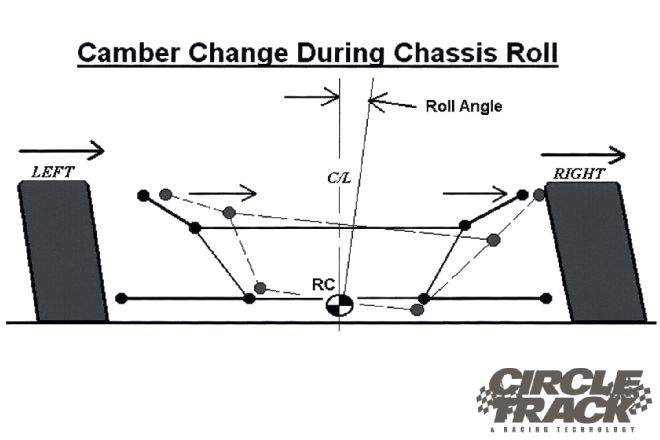 <strong>4</strong>. Besides chassis dive, when we turn the car left, the chassis also rolls. As the chassis pick-up points move in roll, the upper ball joints move to the right. This causes the LF wheel to further loose camber toward the negative and the RF wheel to move toward positive camber.
<strong>4</strong>. Besides chassis dive, when we turn the car left, the chassis also rolls. As the chassis pick-up points move in roll, the upper ball joints move to the right. This causes the LF wheel to further loose camber toward the negative and the RF wheel to move toward positive camber.
Measuring Camber Change
We can measure camber change by several different methods. In the shop, we can set the chassis ride heights just as they would be at mid-turn on the racetrack and then directly measure the camber at each wheel. To do this, we will need to know the shock travel at mid-turn, which is very hard to estimate.
If we look at the shock travel indicators on the shaft of the shock, they always tells us total shock travel which includes braking, going over bumps, banking changes such as exiting the racetrack and driving down onto the apron (this could be quite a lot of LF shock travel at some high banked racetracks) or something as simple as steering the car back and forth to warm the tires before running hot laps.
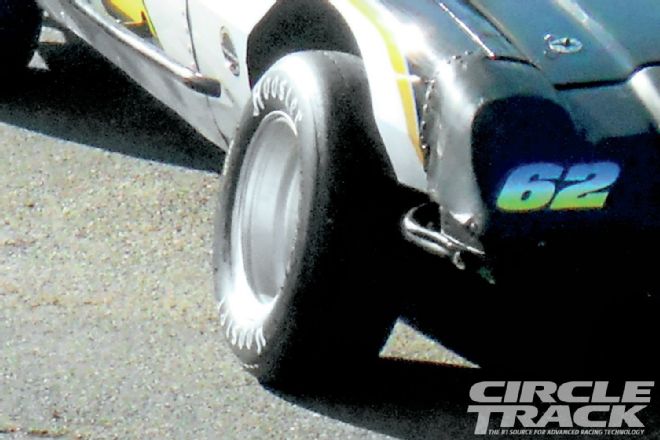 <strong>5</strong>. The taller and narrower the tire, the more camber you will need in order to maintain a proper contact patch footprint.
<strong>5</strong>. The taller and narrower the tire, the more camber you will need in order to maintain a proper contact patch footprint.
Conclusion
Remember that camber settings are important so that the front end will have the maximum amount of footprint and traction to use to turn the car at mid-turn. Many of our problems related to a car that won't turn well come from incorrect camber settings and camber change problems.
Often, a car that has a serious push can be helped by analyzing and adjusting the static camber, as well as knowing the camber change amounts. For dirt cars, taking tire temperatures may not be feasible, but measuring tire wear can have the same effect as temperatures. The more wear, probably the more temperature that part of the tire experiences. Even wear translates to more even tire temperatures and the best camber settings.